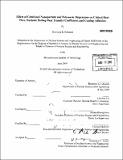Effect of combined nanoparticle and polymeric dispersions on critical heat flux, nucleate boiling heat transfer coefficient, and coating adhesion
Author(s)
Edwards, Bronwyn K
DownloadFull printable version (30.54Mb)
Other Contributors
Massachusetts Institute of Technology. Dept. of Nuclear Science and Engineering.
Advisor
Lin-wen Hu and Jacopo Buongiorno.
Terms of use
Metadata
Show full item recordAbstract
An experimental study was performed to determine thermal performance and adhesion effects of a combined nanoparticle and polymeric dispersion coating. The critical heat flux (CHF) values and nucleate boiling heat transfer coefficients (HTC) of nickel wires pre-coated using 1.0% alumina, 0.1% alumina, 500ppm polyallylamine hydrochloride (PAH), and 0.1% alumina combined with 500ppm PAH dispersions were determined using the pool-boiling method. The adhesion of 0.1% alumina and combined 0.1% alumina and 500ppm PAH coatings was evaluated using the tape and modified bend test methods. Results of the pool boiling experiments showed that the wire heaters pre-coated with combined 0.1% alumina and 500ppm PAH dispersion increase the CHF in water by -40% compared to bare wire heaters, compared to an enhancement of -37% with a 0.1% alumina coating. The combined 0.1% alumina and 500ppm PAH dispersion degrades the wire HTC by less than 1%, compared to a degradation of over 26% with a 0.1% alumina coating. Results from the tape test indicate qualitatively that the combined 0.1% alumina and 500ppm PAH dispersion coating adheres better than the 0.1% alumina nanoparticle coating. Results from the modified bend test showed that the combined 0.1% alumina and 500ppm PAH dispersion coating did not fail at the failure strain of the 0.1% alumina nanoparticle coating (8.108x 10-4). The addition of PAH to alumina nanofluid for creating a nanoparticle coating through boiling deposition was found to improve both coating thermal performance and adhesion over the pure alumina nanofluid.
Description
Thesis (S.M. and S.B.)--Massachusetts Institute of Technology, Dept. of Nuclear Science and Engineering, 2009. Cataloged from PDF version of thesis. Includes bibliographical references (p. 123-126).
Date issued
2009Department
Massachusetts Institute of Technology. Department of Nuclear Science and EngineeringPublisher
Massachusetts Institute of Technology
Keywords
Nuclear Science and Engineering.